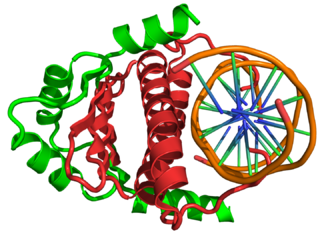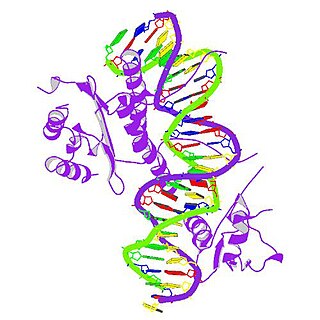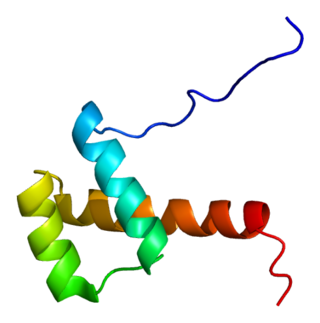Transcription factor GATA-6, also known as GATA-binding factor 6 (GATA6), is protein that in humans is encoded by the GATA6 gene. [5] The gene product preferentially binds (A/T/C)GAT(A/T)(A) of the consensus binding sequence. [6]
Transcription factor GATA-6, also known as GATA-binding factor 6 (GATA6), is protein that in humans is encoded by the GATA6 gene. [5] The gene product preferentially binds (A/T/C)GAT(A/T)(A) of the consensus binding sequence. [6]
Mutations in the gene have been linked with pancreatic agenesis and congenital heart defects. [7]
GATA-6, a zinc finger transcription factor, is important in the endodermal differentiation of organ tissues. [8] It is also indicated in proper lung development by controlling the late differentiation stages of alveolar epithelium and aquaporin-5 promoter activation. Furthermore, GATA-6 has been linked to the production of LIF, a cytokine that encourages proliferation of endodermal embryonic stem cells and blocks early epiblast differentiation. If left unregulated in the developing embryo, this cytokine production and chemical signal contributes to the phenotypes discussed further below. [9]
Upon the disruption of GATA-6 in an embryo, the distal lung epithelial development is stunted in transgenic mice models [8] The progenitor cells, or stem cells, for alveolar epithelial tissues develop and are specified appropriately, however further differentiation does not occur. Also the distal-proximal bronchiole development is affected, resulting in a reduced quantity of airway exchange sites. [8]
This branching deficit, which will cause bilateral pulmonary hypoplasia after birth, has been locally associated with areas lacking differentiated alveolar epithelium, implicating this phenotype as inherent to endodermal function, and thus may be indirectly linked to improper GATA-6 expression. [10] [11] That is, a deficit of bronchiole branching may not be a result of direct transcriptional error in GATA-6, but rather a side effect of such an error.

The TATA-binding protein (TBP) is a general transcription factor that binds specifically to a DNA sequence called the TATA box. This DNA sequence is found about 30 base pairs upstream of the transcription start site in some eukaryotic gene promoters.

Histone acetyltransferase p300 also known as p300 HAT or E1A-associated protein p300 also known as EP300 or p300 is an enzyme that, in humans, is encoded by the EP300 gene. It functions as histone acetyltransferase that regulates transcription of genes via chromatin remodeling by allowing histone proteins to wrap DNA less tightly. This enzyme plays an essential role in regulating cell growth and division, prompting cells to mature and assume specialized functions (differentiate), and preventing the growth of cancerous tumors. The p300 protein appears to be critical for normal development before and after birth.
SOX genes encode a family of transcription factors that bind to the minor groove in DNA, and belong to a super-family of genes characterized by a homologous sequence called the HMG-box. This HMG box is a DNA binding domain that is highly conserved throughout eukaryotic species. Homologues have been identified in insects, nematodes, amphibians, reptiles, birds and a range of mammals. However, HMG boxes can be very diverse in nature, with only a few amino acids being conserved between species.

In the field of molecular biology, myocyte enhancer factor-2 (Mef2) proteins are a family of transcription factors which through control of gene expression are important regulators of cellular differentiation and consequently play a critical role in embryonic development. In adult organisms, Mef2 proteins mediate the stress response in some tissues. Mef2 proteins contain both MADS-box and Mef2 DNA-binding domains.

GATA transcription factors are a family of transcription factors characterized by their ability to bind to the DNA sequence "GATA".

Transcription factor GATA-4 is a protein that in humans is encoded by the GATA4 gene.

GATA2 or GATA-binding factor 2 is a transcription factor, i.e. a nuclear protein which regulates the expression of genes. It regulates many genes that are critical for the embryonic development, self-renewal, maintenance, and functionality of blood-forming, lympathic system-forming, and other tissue-forming stem cells. GATA2 is encoded by the GATA2 gene, a gene which often suffers germline and somatic mutations which lead to a wide range of familial and sporadic diseases, respectively. The gene and its product are targets for the treatment of these diseases.

Serum response factor, also known as SRF, is a transcription factor protein.

Myocyte-specific enhancer factor 2A is a protein that in humans is encoded by the MEF2A gene. MEF2A is a transcription factor in the Mef2 family. In humans it is located on chromosome 15q26. Certain mutations in MEF2A cause an autosomal dominant form of coronary artery disease and myocardial infarction.

NK2 homeobox 1 (NKX2-1), also known as thyroid transcription factor 1 (TTF-1), is a protein which in humans is encoded by the NKX2-1 gene.

Transcription factor HES1 is a protein that is encoded by the Hes1 gene, and is the mammalian homolog of the hairy gene in Drosophila. HES1 is one of the seven members of the Hes gene family (HES1-7). Hes genes code nuclear proteins that suppress transcription.

MHC class II regulatory factor RFX1 is a protein that, in humans, is encoded by the RFX1 gene located on the short arm of chromosome 19.

Hematopoietically-expressed homeobox protein HHEX is a protein that in humans is encoded by the HHEX gene and also known as Proline Rich Homeodomain protein PRH.

C-terminal-binding protein 2 also known as CtBP2 is a protein that in humans is encoded by the CTBP2 gene.

Nuclear transcription factor Y subunit gamma is a protein that in humans is encoded by the NFYC gene.

Paired related homeobox 1 is a protein that in humans is encoded by the PRRX1 gene.

Transcription factor GATA-5 is a protein that in humans is encoded by the GATA5 gene.

Zinc finger protein ZFPM2, i.e. zinc finger protein, FOG family member 2, but also termed Friend of GATA2, Friend of GATA-2, FOG2, or FOG-2, is a protein that in humans is encoded by the ZFPM2 and in mice by the Zfpm2 gene.

Homeobox protein Hox-D1 is a protein that in humans is encoded by the HOXD1 gene.

Transcription factor AP-2 beta also known as AP2-beta is a protein that in humans is encoded by the TFAP2B gene.